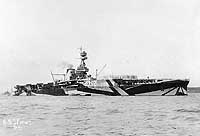
HMS Furious, a 19,513-ton aircraft carrier, was built at Newcastle-on-Tyne, England. Begun as a light battle cruiser (or "large light cruiser") of modified Courageous class, she was modified in the latter stages of construction and completed in July 1917 with a single 18-inch gun aft and an aircraft launching platform forward. After several months' experience with the Grand Fleet, she was further modified, receiving an aircraft landing deck and hangar aft. With the completion of that work in March 1919, Furious returned to the North Sea, providing important experience in the operation of combat landplanes at sea. On 19 July 1918, she launched a historic air strike that destroyed two enemy airships and their support facilities at Tondern, in northern Germany. A month earlier, in another historic incident, she had used both anti-aircraft guns and fighter aircraft to thwart an attack by German seaplanes. Following the end of World War I, the carrier operated in the Baltic Sea.
Her wartime aircraft landing arrangements having proved very unsatisfactory, Furious was laid up in reserve in late 1919. After futher experience with other aircraft carriers, she was massively reconstructed, emerging in August 1925 as a 22,450-ton ship with upper and lower hangars, topped by a long flight deck clear of obstructions, with a shorter aircraft launching deck at the bow. This configuration established a pattern for other British and Japanese aircraft carriers of that era.
Furious operated actively through the inter-war years, continuing her pioneering work as a platform for developing seagoing aviation techniques and combat doctrine, as those applied to the situations confronting the Royal Navy. In the later 1930s, her small forward aircraft flying-off deck was converted to a gun platorm and she was refitted with a small "island" superstructure amidships on the starboard side of the upper flight deck.
Through the first five years of World War II, Furious served with the Home Fleet in the Atlantic area. By mid-war, she was quite elderly, limited in capabilities, and required continual maintenance. She took part in an attack on the German battleship Tirpitz in April 1944, but was placed in reserve later in that year. After post-war employment in target trials, HMS Furious was sold for scrapping in January 1948.
This page features all our 1917-20 views of the British aircraft carrier Furious, and provides links to those taken later in her career.
For images of HMS Furious taken after her 1921-25
reconstruction, see:
| If you want higher resolution reproductions than the digital images presented here, see: "How to Obtain Photographic Reproductions." |
Click on the small photograph to prompt a larger view of the same image.
For images of HMS Furious taken after her 1921-25
reconstruction, see:
| If you want higher resolution reproductions than the digital images presented here, see: "How to Obtain Photographic Reproductions." |
Page made 12 July 2001